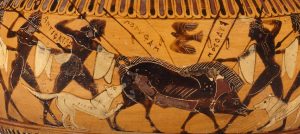 Humans and pets have had a long history together. Through a symbiotic relationship with animals, we have evolved together throughout eons. The domestication of animals occurred because of the mutual benefit humans and animals saw in interacting with each other. Though humans are said to make conscious choices, animals still reacted in ways that corresponded to their advancement, whether that was being fed regularly, being protected, or being companions. Let us explore the history of pets to comprehend how human and animal interaction became gradually more symbiotic.
Humans and pets have had a long history together. Through a symbiotic relationship with animals, we have evolved together throughout eons. The domestication of animals occurred because of the mutual benefit humans and animals saw in interacting with each other. Though humans are said to make conscious choices, animals still reacted in ways that corresponded to their advancement, whether that was being fed regularly, being protected, or being companions. Let us explore the history of pets to comprehend how human and animal interaction became gradually more symbiotic.
The extant gray wolf was a wild and fierce pack animal, but somehow, humans tamed it. How did this happen? There are many theories, as the genetic material has been mixed between dogs and wolves, plus the evolution of dogs have not been entirely linear (Larson G., Bradley D.G.). However, it is generally agreed that about 15,000 years or even longer ago, humans and gray wolves began hunting together, and to build a symbiotic relationship. The wolves and humans would help kill off prey and they would both share in the spoils of their hunting. Of course, there was not an instant relationship between them, but trust was eventually built between the two species (Larson G.).
It is uncertain whether the domestication of wolves, eventually becoming dogs through generations, was done on the behalf of humans or wolves. But what is certain is that eventually, the tamer wolves stayed more with humans, and started to breed with other tame wolves. These tame wolves bred wolves with different characteristic based on their genetic makeup. The anomalies were subtle at first, but ultimately grew more distinct from their ancestors—the usually fierce extant gray wolf. Different colors, curled tails, and the like began to appear with selective breeding (Science Focus).
Over the centuries, from this taming of wolves came breeds that focused on certain characteristics and functions. For instance, the oldest living breed of dog is the basenji, which is featured in sculptures and tombs of ancient Egypt (IHeartDogs.com). And according to Dogtime.com, “He uses both scent and sight to hunt and was originally used to flush small game into a hunter’s nets and to control village rodent populations. Clever and endearing, he’s a good companion for the person or family who can stay a step ahead of him” (Dogtime). But dogs were ultimately used for more than hunting partners. They became companions, war tools, assistants for disabled people, drug finders, babysitters, and more. Though the initial evolution of extant gray wolf into dog is unclear in its circumstances, it is understood that humans have done intentional breeding of certain types of dogs to fit their needs (Bennett, Jacqueline, et al).
Modern pet keeping began in Britain in the seventeenth century, the Victorian Era. Aristocrats were the first to keep them continuously as companions and hunters, so owning a pet was a sign of elitism. This is not to say that before dogs were not kept as pets, but it was first in the Victorian Era that we saw dogs living in human residences most of the day. However, in the nineteenth century, the middle class grew, and with it, dogs as pets became common within middle class households as well. From this time, the practice of dogs being kept in normal households gradually spread worldwide (Amato, Sarah).
Dogs are now an integral part of human society, whether we admit it or not. From the dangerous extant gray wolf of ancient history, these creatures eventually joined humans in a symbiotic relationship that fostered a new evolutionary branch for both species. Now, we even have dog whispers, dog trainers, and dog psychologists, while dogs innately understand us through genetics. It looks like our evolution together continues in earnest.
References
Larson G., Bradley D.G. (2014). “How Much Is That in Dog Years? The Advent of Canine Population Genomics.” PLOS Genetics. 10 (1): e1004093. doi:10.1371/journal.pgen.1004093. PMC 3894154 Freely accessible. PMID 24453989.
Larson G. (2012). “Rethinking dog domestication by integrating genetics, archeology, and biogeography.” PNAS. 109 (23): 8878–8883. doi:10.1073/pnas.1203005109. PMC 3384140. PMID 22615366.
“How Did Humans Tame Wolves?” Science Focus, www.sciencefocus.com/qa/how-did-humans-tame-wolves.
“The 10 Most Ancient Dog Breeds.” IHeartDogs.com, iheartdogs.com/10-oldest-dog-breeds/.
“Basenji Dog Breed Information, Pictures, Characteristics & Facts.” Dogtime, dogtime.com/dog-breeds/basenji#/slide/1.
Bennett, Jacqueline, et al. “The Truth About Dog Breeding.” Rover.com, 8 Oct. 2015, www.rover.com/blog/history-breeding-dogs/.
Amato, Sarah (2015). Beastly Possession: Animals in the Victorian Consumer Culture. Toronto: University of Toronto Press. p. 25.
Sign up and we’ll send you ebook of 1254 samples like this for free!
- 80+ essay types
- 1000+ essay samples
- Pro writing tips
Previous answers to this question
This is a preview of an assignment submitted on our website by a student. If you need help with this question or any assignment help, click on the order button below and get started. We guarantee authentic, quality, 100% plagiarism free work or your money back.
 Get The Answer
Get The Answer